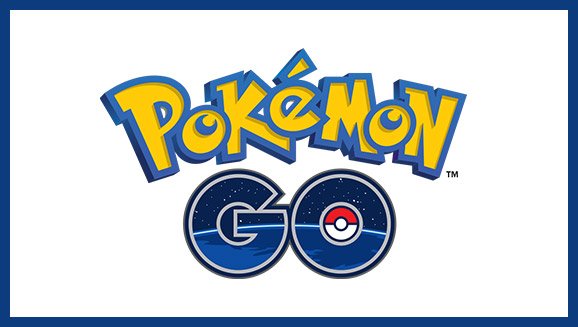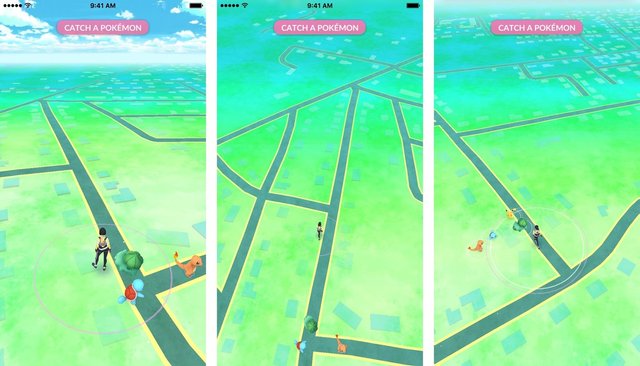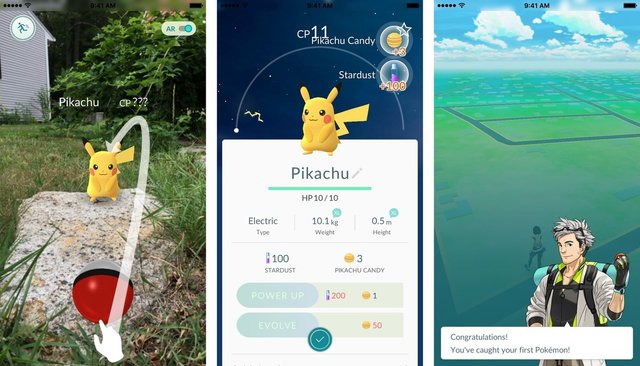Pokémon Go Begginers guide
New to Pokemon Go and looking for some help getting started? Here's our beginners guide!
Most people have at least heard of Pokémon — Nintendo's ever-popular title — which asks players to travel a fictional world in order to collect every creature out there. But today's world is not the world of the 1990s: Nintendo and Niantic Labs have teamed up to let players catch Pokémon in the very world we live in, thanks to a combination of GPS, augmented reality, and dorky-cute graphics.
What the heck is Pokémon Go?

If you've been living under a rock or otherwise have kept yourself off the internet this weekend, you may have missed the official launch of Niantic and Nintendo's already-ridiculously-popular new game, Pokémon Go.
It retains the basics of Pokémon games past — catching Pokémon, battling at Gyms, using items, evolving your creatures — with a crazy twist: You're doing it all in the real world. That means instead of tapping or using a D-pad to tell your virtual avatar where to go to find Pokémon, you're actually walking. In the real world. Crazy, we know.
You may have stumbled onto this page knowing nothing about Pokémon. That's okay. You don't have to be a fan of the previous games or even know the lore to have fun with this game: While it may overtly promote itself as a game about catching Pokémon and battling, the real joy is exploring the real world with your friends, giggling while you check in at historical monuments disguised as PokéStops, and making new connections in your neighborhood with other would-be Pokétrainers.
Before you dive in to Pokémon Go, you'll want to get the hang of how the game works. That means knowing the world, its mechanics, and how to access your Pokédex, Items, and more.
To sign up for the game, you'll need to use your Google account or sign up for a Pokémon Trainer Club account. Pokémon Go stores all your information on its servers, so you'll need to use one of these two methods to link your Pokémon data to your device.
After signing up, you'll want to customize your digital avatar. You can choose your gender, eye color, hair color, shirt, hat, pants, shoes, and the style of your backpack. Once you've done so, you'll enter the main area of the game: The Pokémon Go map.
Essentially, the main area of the game is a brightly-animated version of Google Maps. You'll see (unmarked) roads, rustling grass (marking Pokémon in the area), and local landmarks disguised as PokéStops and Pokémon Gyms. As you move in the real world, your avatar does too. Pokémon will pop up on the map with a small vibration as you walk along, and if you tap on them, you can try to capture them.
Player icon: Your player icon is at the bottom left corner of the screen. Tap on this to view your character's information, as well as a list of in-game achievements.
Backpack: This is where all the items you pick up on your journey are stored.
Pokédex: Your index of Pokémon, complete with information on all the species you've already caught.
Pokémon: Here, you can see all the Pokémon that are in your possession.
Nearby Pokémon: Tap on the bottom right corner of the screen to see which Pokémon are nearby.
What you need to know about Pokémon
Whether you've never caught a Pokémon before or you've been collecting these creatures since childhood, you'll quickly get introduced to the Pokémon of this world after starting the game. (Heck, the very first screen you see after logging in is of a giant Gyarados menacing an unaware player, as a warning to stay alert while playing.)
At the start, you'll only be able to catch Nintendo's original lineup of Pokémon — those found in the Red, Blue, and Yellow titles — though we expect expansions to appear as the game grows and works out the bugs.
Pokémon come in variety of types, shapes, and sizes: Of the over 100 Pokémon available for capture, you'll find creatures of the Fairy, Psychic, Electric, Grass, Water, Ghost, Bug, Rock, Ground, Poison, Flying, and Normal type. We haven't spotted any Legendary Pokémon quite yet, but that doesn't mean they aren't out there hiding.
Where to find different types of Pokémon
Each geographical area has a specific Pokémon type, and some creatures are more difficult to find than others. If you keep running into the same group of Pidgey and Caterpie, don't lose hope: You need to travel around your area to find all the Pokémon. You can head to local lakes, ponds, or beaches to find Water-type Pokémon, for example, or wait until the evening to have a better chance at grabbing a Fairy type.
How to catch your first Pokémon
As with all Pokémon games, when a trainer begins their first journey, they're given a choice of which Pokémon to start with. After you've finished customizing your avatar, three Pokémon will appear in front of you. You can choose from Bulbasaur, Charmander, or Squirtle; after capturing one, the other two will disappear.
But wait: There's more. If you walk away from the original three four times, you'll get a fourth starter Pokémon option: Pikachu.
How to start the game with Pikachu
Who needs Bulbasaur, Squirtle, or Charmander when you have Pikachu? Here's how to start the game with everyone's favorite little electric Pokémon.
In true Nintendo tradition, Niantic Labs has provided intrepid Pokémon fans with a fun little hack at the beginning of the game: Instead of starting out with Charmander, Bulbasaur, or Squirtle, you can choose Pikachu — if you're willing to walk.
First discovered by Polygon, you can pick everyone's favorite starter electric Pokémon by repeatedly ignoring the trio of starter Pokémon in front of you. Here's how to go about doing it.
How to get Pikachu as your starter Pokémon
- Sign up for a Pokémon Go account.
- Make your avatar.
- When the Professor prompts you to "Catch a Pokémon," walk away from Bulbasaur, Squirtle, and Charmander.
- If you walk far enough away, the trio will respawn and your phone will vibrate. (We recommend walking along a sidewalk in your neighborhood to trigger this.)

5.Repeat step 4 3-5 more times, and a fourth Pokémon will appear: Pikachu!

NOTE: Polygon managed to make Pikachu appear after just 4 respawns, but it took me 5 to make this happen. Your mileage may vary.
How to catch other Pokémon
Once you've gotten started with the game and captured your first Pokémon, it's time to go hunting for some others.
How to track and find nearby Pokémon in Pokémon Go
You can find wild Pokémon by physically walking around your area. Stick to populated areas: Pokémon appear most often near PokéStops. The more PokéStops nearby, the more creatures should appear. Try visiting locations with a lot of public art; tourist spots or malls are great starting points.
As you walk around in the real world, your avatar moves along the map using GPS. When a Pokémon is close enough to capture, it pops up on your screen. Since walking around with your eyes glued to your phone is a bit of a safety hazard, the game is designed to allow you to keep your eyes free while you wander. You can keep your phone at your side while you walk; when you are near a Pokémon, you'll get a notification in the form of a vibration and (if your sound is turned on) the Pokémon's unique call.
You can then move to a safe location (if you were walking along a road, for instance), and tap the visible Pokémon to capture it. Tapping zooms in on your avatar and launches an augmented reality experience with the Pokémon dancing around amidst your surroundings. If you don't see it on the screen immediately in front of you, move your device around until it appears. (There are arrows on the side of the screen to guide you in the right direction.)
If AR makes you nauseous or you don't want your battery drained, you can always turn the feature off in the upper right corner.
Once you've found the Pokémon, it's time to throw a Poké Ball to try and capture it. You "throw" in game by tapping and holding on your Poké Ball; a glowing, shrinking ring appears then around the Pokémon. When the ring gets to its smallest, you want to flick your Poké Ball directly toward the creature (with the aim of bopping it on the head) and release your finger; if successful, you'll capture the Pokémon inside.
Not all Pokémon enjoy being inside itty bitty areas, however, and some may jump out of your Poké Ball after one or two shakes. If this happens, you'll want to throw another Poké Ball to try and recapture it — or, if you're running low on supplies, run away.
As you progress in the game, you'll encounter stronger Pokémon that require a more powerful Poké Ball (or Razz Berries, which lull the Pokémon to complacency). If the ring surrounding the Pokémon is green, you should have no problem capturing it; if it's yellow, you have a fifty-fifty chance; when you see a red ring, you'll need to use multiple Poké Balls, more powerful Poké Balls, or Razz Berries to have a remote chance of catching it.
More than one player can catch the same Pokémon; if you and your friend see the same Pokémon on the street, you can both grab it for your separate collections.
You can also use special items to attract Pokémon to your location: You can use incense to lure Pokémon to you personally for 30 minutes, or — if you're at a PokéStop — use a Lure Patch. This will bring Pokémon to the stop; every player there can catch them for the next 15 minutes.
#pokemongo #nintendo #pokeball #pikachu #pokeball
Congratulations @henchman! You have received a personal award!
Click on the badge to view your own Board of Honor on SteemitBoard.
For more information about this award, click here
Congratulations @henchman! You received a personal award!
You can view your badges on your Steem Board and compare to others on the Steem Ranking
Vote for @Steemitboard as a witness to get one more award and increased upvotes!